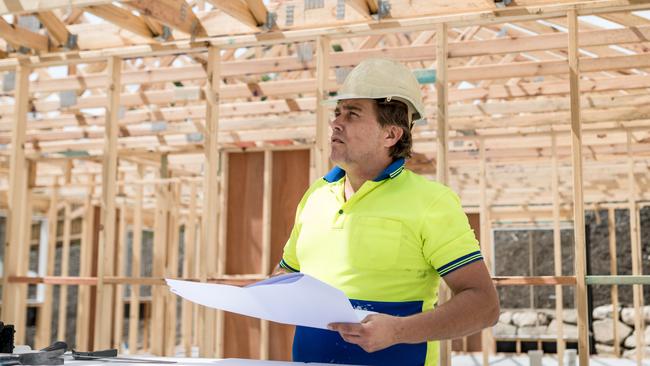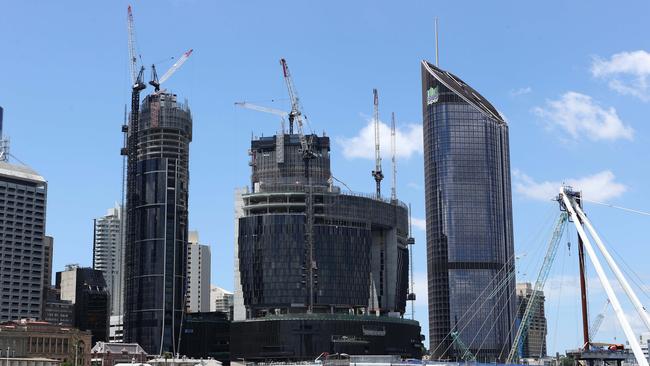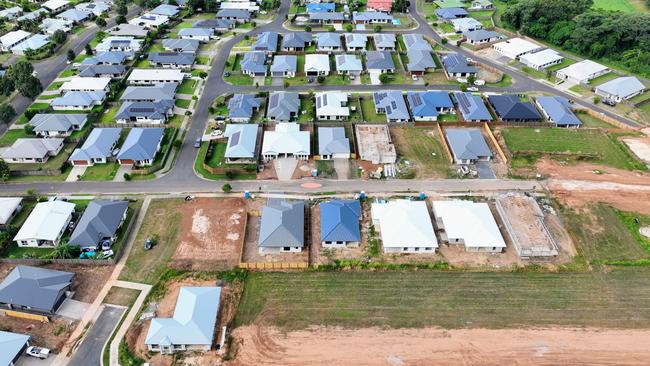Housing diversification and better planning to make housing more affordable and abundant: industry
Australia’s housing market is troubledwith a dearth of homes creating an affordability challenge across sales and rental markets. Developers want a co-ordinated effort to deliver more properties.

Business
Don't miss out on the headlines from Business. Followed categories will be added to My News.
Greater housing diversification and improved planning are needed if Australia wants to truly tackle the chronic shortage of homes which is challenging affordability and driving up rents, according to top property figures.
But the cards are stacked against more housing supply being added to the market over the next few years amid a wave of builder collapses, higher costs and interest rate pressures.
Building approvals have slumped to the lowest levels in 15 years after a bumper start to the decade, which was assisted by significant pandemic stimulus.
But the surge in demand caught out many home builders as they took on unprofitable work and hit the wall, worsening housing supply problems.
A shortfall of 106,300 homes will emerge over the next five years as both detached and unit construction weakens through to 2025, according to the federal government’s housing body, the National Housing Finance and Investment.

Speaking ahead of the body’s State of the Nation’s Housing event, Stockland chief executive Tarun Gupta said more must be done to diversify Australia’s market.
“While undoubtedly our biggest lever, increasing the supply of private housing on its own will not solve Australia’s affordability crisis,” he said.
“It requires action across the entire housing continuum – from investment in social and affordable housing, build-to-rent and shared equity, to the sale of private houses – and diversity of product to suit people’s lifestyles and life stages.”
The need for new forms of housing is creating a huge opportunity for private capital and foreign investment to unlock the potential of these alternative asset classes. This could help shoulder some of the affordability burden playing out across the market, said Sophie Fallman, the managing partner of Brookfield’s Real Estate Group and head of real estate in Australia.
“We’re already seeing foreign capital having led the establishment of the multifamily and student accommodation sectors in Australia, and there are many examples globally where, with the right policy and support in place, private capital and foreign investment can be instrumental in delivering a variety of housing solutions that answer issues of affordability and provide attractive alternatives for dwellers and investors alike,” she said.
The lack of housing is affecting not only availability but also prices as demand continues to grow with migration.
Earlier this week, Westpac became one of the latest institutions to revise its house price forecasts upwards after key indicators highlighted a stabilisation – and in some areas rises – in prices through the first third of the year.
The major bank cited strong auction results, lower sales numbers and fewer homes being offered as creating a floor under the market, with peak-to-trough declines of 10 per cent instead of 16 per cent.
However, it also noted the fundamentals for a rebound and recovery were not strong. Rental vacancy rates also continue to hold at low levels of 1 per cent – well below the 3 per cent considered a “healthy” market dynamic.
National Housing Finance and Investment CEO Nathan Dal Bon said most Australians feel the impact of increases.
“We are facing extraordinary pressures on housing affordability for both homeowners and renters, with the past year seeing the strongest and fastest synchronised upswing in rents across Australia’s major capital cities in the last two decades,” he said.

Rapidly rising construction costs have dampened the outlook for dwelling construction. As a result, some developers are choosing to put projects on hold over concerns of cost blowouts despite achieving solid sales, while others have had to go back to customers and ask for additional funds or significantly alter designs to make them viable.
However, planning is also a significant hurdle in bringing new supply to the market, particularly for in-fill projects. In NSW alone, a 75 per cent increase in the number of new homes coming to market is required, Mr Gupta said.
“It is between these two ends of the spectrum that we need to be focusing more; to rethink existing models and consider how we can move people from social housing to supported rentals and affordable housing, and eventually to private housing,” he said.
However, improving the efficiency of Australia’s planning regime was heralded by Mirvac’s CEO of development and the Property Council of Australia’s chair of the Residential Development Council, Stuart Penklis, as necessary to make this possible.
“One of the biggest impediments to the delivery of the housing that is needed across the country is the efficiency and effectiveness of our planning systems,” Mr Penklis said.
“All levels of government need to work together, alongside industry and the community, on a co-ordinated plan and approach to help unlock a diverse range of housing across the country. We have seen significant debate about this issue over many years, and now is a time to put a holistic strategy in place to deliver a progressive and sustainable housing plan.”
The sentiment was echoed by Mr Dal Bon, who said long-term solutions require collaboration between governments and the private sector.
Surging migration is also playing into the housing crisis. It has already prompted a spike in the number of overseas searches for Australian property, particularly from China and India, which have a large student cohort enrolled in local universities.
Covid-19 also sparked a wave in the number of expats returning to live in Australia, with open borders likely to see a net 350,000 people settle this financial year.

Brookfield’s Ms Fallman sees the living sector as generally attractive to invest in, with emerging alternatives such as build-to-rent, manufactured housing, student housing and seniors, alongside traditional forms of low- and high-density housing, showing “strong demographic tailwinds”.
Governments recognise the challenge and have offered incentives for build-to-rent projects. But the industry has argued that more needs to be done at the federal level.
While private capital is waiting in the wings, Mr Gupta believes the government needs to incentivise firms further to pull the trigger on an investment, referencing the success of similar initiatives introduced in Britain.
“This will require a greater role for government, not just in investing in housing but creating the incentives and policy settings that make models like build-to-rent commercially viable at scale,” Mr Gupta said.
“It will also require the private sector to take more responsibility for working at each point of the spectrum, partnering with community housing providers and instructional capital to create more confidence in delivery at scale.”
NHFIC forecasts construction in both the detached and unit space will begin a sustained pick-up from 2026 through to 2033 to significantly surpass today’s low levels of activity. But getting there will require substantial reform.
More Coverage

Originally published as Housing diversification and better planning to make housing more affordable and abundant: industry





